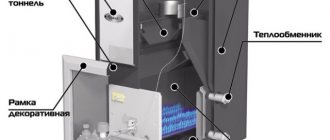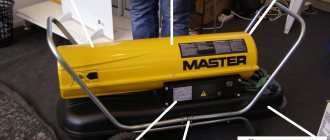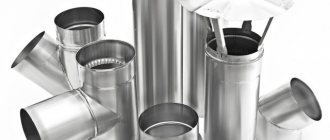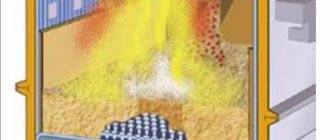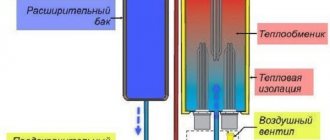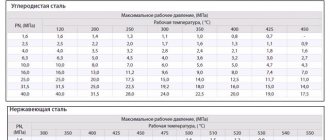Features of the thermal curtain
The thermal curtain is a long fan that creates a flat and powerful flow of warm air. Its main function is to create an invisible barrier to the penetration of cold air masses into the room. An air thermal curtain is like a closed door in those buildings where there is always a large flow of people and the door is constantly opening and closing.
Thermal curtains are especially important in restaurants, shops, passageways, lobbies of business centers, and subways. You can install a thermal curtain for your home, cottage, or garage.
As for the installation location - above the door or above the window. The curtain does not allow heat to disappear from the room when the front door is constantly open for a long period of time.
How is the water curtain controlled?
The water thermal curtain is accompanied by at least two switches, one of which must turn on the fan, and the other must turn on the heating elements. Heating power regulators that have two or three stages can also be installed. Fans can be two-speed. The air curtain may have a thermostat that turns off the device or heating elements when the set temperature is reached.
There is a built-in and wired control panel, it all depends on the chosen model. However, the built-in type is used on small-sized curtains that are installed for windows and doors. This is explained by the fact that the ability to reach the buttons depends on the distance. Accordingly, for water curtains it is more rational to use remote controls that can be installed in the right place.
Sometimes a limit switch is used, which is convenient because it turns on the device only when the gate is open. It turns out that the switch starts working when the doors or gates are opened. Its use is very convenient in warehouses and hangars.
Design and operating principle
The main element in the design of this device is the air duct. It is he who evenly distributes the air flow. The air is directed at a specific angle of 40° in the inlet plane due to special guide plates that are installed on the air duct.
In addition, the design necessarily includes a heating element, fans and filters.
There is nothing difficult to understand in the functioning of a thermal curtain. The high-power fan installed in the structure creates a strong flow of warm air.
This flow creates a curtain that prevents internal and external air masses from mixing. Thus, the room temperature remains stable.
It is worth saying that the price of the design in question is relatively high when compared with the cost of classic radiators and air conditioners, however, the power characteristics and efficiency of maintaining a stable temperature are well worth the investment.
Operating principle of the NeoClima TZT-1820 thermal curtain
Main element
The main design element is a radial fan, which is necessary to create the necessary air flow. Such a turbine must be single and located along the entire length of the device. It helps create an even flow. The engine is mounted on the side of it.
However, manufacturers often decide to place the engine in the center, with small turbines on its sides. The reason for this arrangement of elements is the difficulty of manufacturing a turbine with a length exceeding 800 mm. How effective is this installation method? Of course, such a simplified curtain will cost less, but there will be a “dip” in the central part of the air flow, which significantly reduces the protective properties. In addition, the heating elements will be blown unevenly, and this leads to their earlier failure.
Advantages and disadvantages
A description of the positive characteristics of thermal curtains can be made in the following paragraphs:
- They protect buildings from the penetration of cold air masses, insects, and dust from outside.
- Maintains a favorable indoor microclimate.
- Quiet operation.
Automatic adjustment is an absolute advantage and distinctive feature of a thermal curtain, regardless of the design features and breadth of its capabilities.
Setting up the heat curtain can be done quite simply. You can adjust the time it takes for the fan motor to start running and stop, set the heating intensity, etc.
As you can see, a silent thermal curtain has many advantages, but it is worth mentioning its disadvantages:
- the device is relatively difficult to install;
- for the water type, connection to the central heating network is required;
- significant energy consumption.
Voltage: 220V and 380V
Small commercial series of air curtains with electrical heating with a power of up to 6 kilowatts can be connected to a single-phase network with a frequency of 50 Hz and a voltage of 220V or 230V in accordance with the interstate standard GOST 29322-92. Electric air curtains with a power of over 6 kW are designed for connection to a 3-phase electrical network with a voltage of 380V (or 0.4 kV) and a frequency of 50 Hz. Air curtains without heating or water air curtains of even powerful industrial series can be connected to a single-phase network with a voltage of 220-230V if their engines, the only consumers of electricity in these types of air curtains, allow this possibility.
Kinds
Thermal curtains are distinguished depending on the type of energy source and the type of heating element.
Based on the energy source, the following types of devices under consideration are distinguished:
- Electrical. In this design, air passes through an electric heater. The advantage of an electric thermal curtain is its versatility for any type of premises and ease of installation. This is a compact air-thermal installation with the main disadvantage - high electricity consumption.
- Mermen. In these devices, the heating function was taken over by water heaters, which are the most economical devices. At the same time, water curtains are relatively expensive, as are the labor required to install them. Typically, such devices are installed in industrial buildings.
- Gas. Gas-type devices are new and have been created as an alternative equipment. If it is impossible to install an electric or water curtain, a gas curtain comes to the rescue. A significant advantage of the device is its high energy efficiency, as well as the density and stability of air flow. The disadvantage lies in the possibility of an emergency in case of improper installation or operation.
A water fan heater can also be used to heat industrial premises.
Depending on the built-in heating element, the following thermal curtains are distinguished:
- Spiral. Devices with a spiral are inexpensive, and at the same time, this option has a short service life and is not popular.
- Heating elements. Such thermal curtains are safe and have a long service life. The devices heat a large area and have an average price range.
- With stitch elements. These devices are the newest on the heating equipment market. Two-thirds of modern air curtains already have stitch elements. This type heats up and releases air very quickly, but the cost of such thermal curtains is several times higher than spiral devices and devices with a tubular electric heater.
Vertical thermal curtain near the entrance door
A thermal curtain can be installed in different ways. Thus, the following types of these devices are distinguished:
- Horizontal. These are practical devices. Most of the innovative developments occur in this direction. Installation of such devices is carried out directly above the door or above the window opening.
- Vertical. The production of thermal curtains of this type initially began to solve complex problems. Vertical devices are installed when it is not possible to install horizontal thermal curtains. Installation is carried out on the side of the openings. Such side devices can be useful if: – suspended ceilings are installed in the room; – there is a small gap between the ceiling and the top line of the opening.
To ensure that the installation is carried out efficiently and the vertical device functions rationally, take the measurements of the opening responsibly. Remember that the length of the device must be at least ¾ of the height of the opening.
Criteria for choosing thermal curtains
How to choose the right thermal curtain? There are several parameters that you should pay attention to when choosing a model: the required length of the device, air capacity, turbine design, type and power of heating elements, type of installation, method of controlling the air curtain, etc. Let's analyze these parameters in more detail.
Dimensions
The first thing you should pay attention to when choosing an air-heat curtain is the length of the device. Choose a model whose length will completely cover the doorway, without gaps or uncovered areas. The modern market of climate control equipment offers consumers thermal curtains with sizes from 600 to 2000 mm. As a rule, for standard doorways, models with a length of 800-1000 mm are purchased.

For a standard opening, choose a model with a length of 800-1000 mm
Important! When choosing a device based on this parameter, you should remember one significant nuance. To prevent vibration and reduce axle load, manufacturers limited the length of the turbine to 800 mm.
Longer models are assembled according to a different scheme: with two drives at the edges and an electric drive in the center of the device. This design has a weak point in the form of a violation of the integrity of the air flow in the center of the device. That is why, if it is necessary to cover a large opening, it is better to use several devices, up to 800 mm long, placed as close to each other as possible.
Performance
How to choose the required performance of a thermal curtain for the front door? In order for the curtain to reliably cut off the internal space from external influences, it is necessary that the air flow speed be:
- at the exit from the nozzle 8-9 m/s;
- at the bottom point of the doorway (for location above the doors) 2.5-3 m/s.
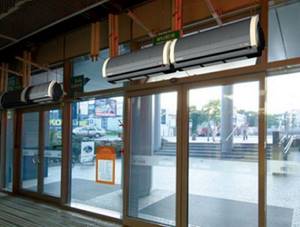
Refer to the above speed values
If these indicators are lower, then outside air may enter the room. If the performance turns out to be excessively high, the owner will face problems with drafts and reduced efficiency of the air curtain.
Calculations have shown that the optimal performance of a curtain for a doorway 80-100 cm wide and 2-2.2 m high is about 900 m3/hour, power - 6-8 kW (depending on the performance of the device and the area of the room). To obtain more accurate calculations, we recommend using the services of specialists. If you plan to install the curtain inside a vestibule, then choose a model whose power is 15% lower than the optimal or calculated one.
Advice! When choosing a model, be guided by the data stated in the technical documentation. Manufacturers indicate what width and height of the opening a particular model is designed for.
Type of heating elements
Despite the fact that most models belong to the class of heating equipment, their function of heating rooms is secondary. The operation of the heating element is not aimed at maintaining the optimal temperature in the room, but only at partially compensating for heat losses through the door.
Electric air-heat curtains use two types of heating elements:
- heating element. The tubular electric heater is characterized by moderate heating, long service life and safety during operation. The disadvantages include a relatively higher cost;
- Spiral. An open spiral made of nichrome (fechral, kanthal, stainless steel) has a rather short service life, gets very hot, burns oxygen and requires a lot of electricity.

Heating element is more expensive, but safe and durable
Today, some premium models are equipped with a micathermic heater, which allows you to control energy consumption modes.
Control
All models present on the Russian market can be classified according to the control method. There are curtains:
- electronic;
- mechanical;
- with and without remote control.
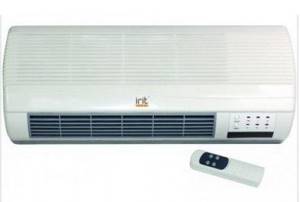
The most convenient control is the remote control
The simplest devices are equipped with three mechanical buttons:
- Power on/off;
- Start the fan;
- Turning on the heating element.
More technically complex models are equipped with an electronic control system, which makes it possible to:
- Smooth or step adjustment of heating temperature;
- Adjust the rotation speed of the turbine, changing the performance of the device;
- Change the angle of the air flow;
- Set the operating time of the device;
- Control the built-in thermostat.
When choosing the optimal model, it is important to consider how control is implemented. This is necessary to ensure the most comfortable operating conditions for the air-thermal curtain. The best option would be to choose a model with a remote control and electronic control.
Installation method
Depending on the design of the thermal curtain and the dimensions of the room, such equipment can be installed horizontally or vertically. Only a specialist can decide which air-thermal curtain is better in a particular case.
Horizontal installation Vertical installation Recessed air curtain
Installing the device above the door is more economical, correct and convenient in terms of the complexity of installation and subsequent operation. There are cases when horizontal installation is not possible due to the design features of the room. In this case, you should choose a model for installation on the side of the opening.
Built-in models are suitable for rooms in which there is a suspended ceiling or a niche is structurally provided within which this device can be installed.
When choosing a model yourself, it is important to understand that installing the device requires about 50 cm of free space above the opening or on the side of the opening. To connect the device, it is necessary to provide a power line of the required power, the necessary safety and protective devices, and prepare the connection point for the device.
Range

As noted above, the main task of a thermal curtain is to create a dense air flow over the entire area of the opening, which makes it possible to neutralize external influences on the air in the room.
Today, the climate control equipment market offers a range of models, the range of which (height of the “air web” without loss of quality characteristics) varies from 1.5 to 8 meters.
Noise level
To avoid discomfort indoors, you should pay attention to silent models. It should be understood that when installing the device in a residential area, you must be guided by the standards and requirements regulated by SNiP and SanPin. The noise standard for residential premises during the day is 40 dB. If you are faced with the question of how to choose a thermal curtain for installation above the door of a store or office space, then pay attention to models whose upper limit of noise produced will not exceed 55 dB. This indicator is reflected in the technical documentation for the device.
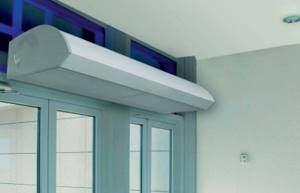
Choose a model with noise emissions below 55 dB
Door opening frequency
This parameter affects the choice of device power. The algorithm is simple: the more often the doors are opened, the more powerful the equipment should be. The correct calculation can be made by using an online calculator or contacting a specialized organization.
Overheat shutdown
Modern models are equipped with a fairly serious set of functions that simplify operation. Everyone determines the issue of functionality based on their needs and financial capabilities. The main thing is that the selected model has a properly implemented safety system, namely, shutdown when overheating. The presence of this function will slightly increase the cost of the model, but will protect it from premature failure, and you from the financial costs of repairing it.
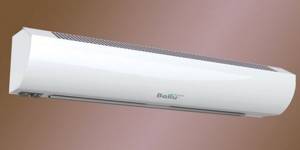
Overheat shutdown is one of the most important functions
Summarizing the above, we have prepared a summary table with recommendations for choosing a thermal curtain model for standard openings.
| Opening size | type of instalation | Supply voltage | Supply voltage |
| 220v | 380v | ||
| 80×210 | Horizontal | Tropic: M-3, A-3 Teplomash: KEV-3p1150e, KEV-4p1150e, KEV-5p1150e, KEV-3p1120e, KEV-4p1120e, KEV-5p1120e, KEV-3p1140e, KEV-4p1140e, KEV-5p1140e Ballu : VNS- 3.000 SB, BHC-3.000 TR Gebo: Ad-306, AN-308 | — |
| Vertical | — | — | |
| 100×220 | Horizontal | Tropic: M-6 Teplomash: KEV-6p2210e Ballu: VNS-6.000 TR Gebo: AN-610 | Tropic: M-6 Teplomash: KEV-6p2210e Ballu: VNS-6.000 TR Gebo: AN-610 |
| Vertical | Teplomash: KEV-6p2220e | Teplomash: KEV-12p3040e, KEV-6p2220e | |
| 100×270 | Horizontal | Teplomash: KEV-6p3230e | Teplomash: KEV-6p3230e |
| Vertical | Teplomash: KEV-6p2220e | Teplomash: KEV-12p3040e, KEV-6p2220e | |
| 120×220 | Horizontal | Tropic: M-6 Teplomash: KEV-6p2210e Ballu: VNS-6.000 TR Gebo: AN-610 | Tropic: M-6 Teplomash: KEV-6p2210e Ballu: VNS-6.000 TR Gebo: AN-610 |
| Vertical | Teplomash: KEV-6p2220e | Teplomash: KEV-12p3040e, KEV-6p2220e | |
| 150×230 | Horizontal | Teplomash: KEV-6p2220e, KEV-6p1260e | Tropic: M-9 Teplomash: KEV-6p2220e, KEV-9p2220e Ballu: BHC-9.000 SR, BHC-9.000 TR Gebo: AN-915 |
| Vertical | Teplomash: KEV-6p2220e | Teplomash: KEV-12p3040e, KEV-6p2220e |
Installation of a thermal curtain
It is best to entrust the installation of this equipment to professional workers. Only they are able to carry out the installation efficiently and make the connection of the thermal curtain reliable. Typically, companies that manufacture these devices also offer installation services.
The technician will always initially carry out verification work, inspect the curtain for integrity and compliance with the package (the kit should include brackets that allow air flow to be directed). Devices can be installed in two ways - horizontally and vertically.
The device is available with a flexible cable and also has a grounding plug. When making a permanent connection (without using a plug), you must work through a central switch with an air gap of more than three millimeters. The connection of this heat curtain can only be carried out by a professional electrician, subject to all necessary rules.
During installation, special wires are used. At the area where the cable enters the device, special sealing rings are used, which are necessary for good protection.
Before connecting the device, it is necessary to establish the correct ventilation process in the room, because various pressure differences can affect the functioning of the air curtain.
Heat curtains need to be attached closer to the openings, but do not forget that the width of the flow must correspond to the size of the door opening.
Installation of the device is carried out only from inside the room. A thermal curtain can only be installed outside if it is necessary to protect the freezer from overheating. The speed of the air flow and its direction are adjusted at the time of installation, and the flow should be directed towards the exit to the street.
Additional differences between thermal curtains
Different types of thermal curtains differ not only in the installation method, type of heating element or energy consumption, but also in other characteristics. The most commonly used classifications of curtain types are based on maximum width and operational features. The following criteria allow you to choose the best option for climate control equipment to solve different problems:
System control method.
Most air curtains are equipped with two switches (fan/heater). At the same time, you can find models that have:
- step regulators of power parameters and heating speed;
- built-in/remote control panels.
Another element that requires special consideration is a thermostat, which automatically turns on/off the heating element at certain temperature conditions inside the room. You can get acquainted with some aspects of choosing thermal curtains by watching the video.
Air intake location and supply temperature.
Depending on where the air enters the thermal curtain from, as well as its outlet temperature, the following types of equipment are distinguished:
- curtains that take air indoors, with or without heating function;
- thermal curtains that take air from the environment, with or without heating function.
Flow direction.
Depending on the direction of air flow, you can select the following types of devices:
- equipment with vertical air supply from bottom to top;
- equipment with vertical air supply from top to bottom;
- equipment with horizontal air supply in only one direction;
- equipment with horizontal air supply in two directions.
The length of the thermal curtain can be from 60 to 200 cm. For standard openings, different types of curtains with a length of 80 to 100 cm are used. The length of the equipment should be slightly greater than the width of the opening. For openings whose length exceeds 200 cm, a design of several thermal curtains is used, which are mounted without a gap between each other.
Jet protection type.
In manufacturers' catalogs you can find two types of thermal curtains based on the type of protection from outside air:
- The shutter type of air flow protection involves complete blocking of air from outside. Such curtains contribute to more economical heating of premises using stationary heating radiators;
- The mixing type of protection provides for partial intake of outside air, which, before being supplied inside the building, undergoes preparation in the form of cleaning and heating. This type of thermal curtains helps saturate the air in the room with oxygen.
Frameless types of thermal curtains.
At some facilities, a more rational option would be to install a pressure unit with a fan separately from the heater and distribution unit. This type of equipment is used for industrial premises with high dust content in indoor areas. Such curtains are called frameless. They are also installed at facilities that belong to a high class of fire and explosion hazard. In this case, the heater is located in a separate room, where there is no likelihood of contact with flammable substances. Using a powerful fan, the already heated air is supplied through a duct system under pressure to the distribution unit.
Splash-proof types of thermal curtains.
This type of equipment is used in car washes. In the category of splash-proof equipment, models are presented for both horizontal and vertical installation. The usual size of such curtains ranges from 300 to 500 centimeters, but, if necessary, it is possible to manufacture equipment with other parameters. They can be equipped with different types of equipment for monitoring and controlling air flow, as well as various means of protection (IP54 protection degree, which ensures safe operation in high humidity conditions, is mandatory). For the manufacture of splash-proof thermal curtains, galvanized or stainless steel is used.
Double-flow types of thermal curtains.
Another type of thermal curtains that can be found in the assortment of some manufacturers is called “double-flow”. The peculiarity of this equipment is the simultaneous formation of two air flows with different temperatures (one flow is warm, and the other is at room temperature). A stream of warm air is supplied closer to the room, and another stream is formed closer to the opening space. This feature of double-flow thermal curtains provides more powerful shielding, which ensures a high level of comfort even in very cold outdoor weather. To create 2 air flows, this type of curtain is equipped with two fans, and, therefore, the energy consumption of such a device increases 2 times, but at the same time 30% heat savings are achieved.
Specifications
To understand how to choose a suitable thermal curtain, you need to understand the basic technical parameters of these devices. Choose the device that will protect your door:
- Dimensions. The length of the device must ensure that the heat flow completely covers the width of the doorway. Even a small gap will significantly reduce the effectiveness of protection from external influences. To select protection over wide doors in large rooms - supermarkets, auto repair shops - you can install several devices located along the entire width of the opening. The height of the device also matters. If it is larger than the free space above the protected opening, then you will probably have to abandon the horizontal type of curtain and consider only options with a vertical type, located on the side of the doors.
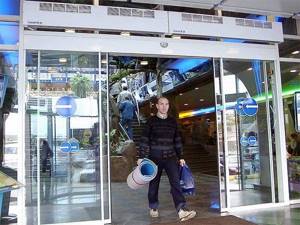
Creating a long thermal curtain from four elements
- Airflow performance. The task of a thermal curtain is not to heat the room - this role is performed by other devices. Therefore, the fan power and, accordingly, the volume of air flow per unit time and its speed are the main parameters of the thermal curtain. To reliably set up a protective flow, its speed at the farthest point is required to be about 2 m/s. To ensure such a flow rate near the floor, it is necessary that the device located at a height of 2.5 m “produce” a speed of about 8 m/s. To ensure such speeds, devices with a capacity of more than 600 m3/hour are required.
- Noise level. If for industrial premises and large supermarkets this is not the most determining parameter, then for household devices it is critical. At home, a noise level of less than 70 dB is required for comfort.
- Availability of automatic control. Manual mode is only good for the simplest and cheapest options. Automatic control of the operation of the curtain and the temperature of its heating elements ensures its efficiency and economy.
- Protective devices. For safety, it is necessary to be able to automatically shut down the system when it overheats.

